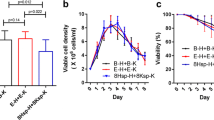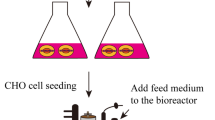Abstract
To improve antibody production in Chinese hamster ovary (CHO) cells, the humanized antibody-producing CHO DP-12-SF cell line was transfected with the gene encoding activating transcription factor 4 (ATF4), a central factor in the unfolded protein response. Overexpression of ATF4 significantly enhanced the production of antibody in the CHO DP-12-SF cell line. The specific IgG production rate of in the ATF4-overexpressing CHO-ATF4-16 cells was approximately 2.4 times that of the parental host cell line. Clone CHO-ATF4-16 did not show any change in growth rate compared with the parental cells or mock-transfected CHO-DP12-SF cells. The expression levels of mRNAs encoding both the antibody heavy and light chains in the CHO-ATF4-16 clone were analyzed. This analysis showed that ATF4 overexpression improved the total production and specific production rate of antibody without affecting the mRNA transcription level. These results indicate that ATF4 overexpression is a promising method for improving recombinant IgG production in CHO cells.






Similar content being viewed by others
References
Asano R, Kawaguchi H, Watanabe Y, Nakanishi T, Umetsu M, Hayashi H, Katayose Y, Unno M, Kudo T, Kumagai I (2008) Diabody-based recombinant formats of humanized IgG-like bispecific antibody with effective retargeting of lymphocytes to tumor cells. J Immunother 31:752–761. doi:10.1097/CJI.0b013e3181849071
Barnes LM, Dickson AJ (2006) Mammalian cell factories for efficient and stable protein expression. Curr Opin Biotechnol 17:381–386. doi:10.1016/j.copbio.2006.06.005
Barnes LM, Bentley CM, Dickson AJ (2004) Molecular definition of predictive indicators of stable protein expression in recombinant NS0 myeloma cells. Biotechnol Bioeng 85:115–121. doi:10.1002/bit.10893
Brewer JW, Hendershot LM (2005) Building an antibody factory: a job for the unfolded protein response. Nat Immunol 6:23–29. doi:10.1038/ni1149
Butler M, Meneses-Acosta A (2012) Recent advances in technology supporting biopharmaceutical production from mammalian cells. Appl Microbiol Biotechnol 96:885–894. doi:10.1007/s00253-012-4451-z
Feige MJ, Groscurth S, Marcinowski M, Shimizu Y, Kessler H, Hendershot LM, Buchner J (2009) An unfolded CH1 domain controls the assembly and secretion of IgG antibodies. Mol Cell 34:569–579. doi:10.1016/j.molcel.2009.04.028
Feige MJ, Hendershot LM, Buchner J (2010) How antibodies fold. Trends Biochem Sci 35:189–198. doi:10.1016/j.tibs.2009.11.005
Gomez E, Powell ML, Bevington A, Herbert TP (2008) A decrease in cellular energy status stimulates PERK-dependent eIF2alpha phosphorylation and regulates protein synthesis in pancreatic beta-cells. Biochem J 410:485–493. doi:10.1042/BJ20071367
Harding HP, Calfon M, Urano F, Novoa I, Ron D (2002) Transcriptional and translational control in the Mammalian unfolded protein response. Annu Rev Cell Dev Biol 18:575–599. doi:10.1146/annurev.cellbio.18.011402.160624
Harding HP, Zhang Y, Zeng H, Novoa I, Lu PD, Calfon M, Sadri N, Yun C, Popko B, Paules R, Stojdl DF, Bell JC, Hettmann T, Leiden JM, Ron D (2003) An integrated stress response regulates amino acid metabolism and resistance to oxidative stress. Mol Cell 11:619–633. doi:S1097276503001059
Hou J, Tyo KE, Liu Z, Petranovic D, Nielsen J (2012) Metabolic engineering of recombinant protein secretion by Saccharomyces cerevisiae. FEMS Yeast Res 12:491–510. doi:10.1111/j.1567-1364.2012.00810.x
Hsu TA, Betenbaugh MJ (1997) Coexpression of molecular chaperone BiP improves immunoglobulin solubility and IgG secretion from Trichoplusia ni insect cells. Biotechnol Prog 13:96–104. doi:10.1021/bp960088d
Huang YM, Hu W, Rustandi E, Chang K, Yusuf-Makagiansar H, Ryll T (2010) Maximizing productivity of CHO cell-based fed-batch culture using chemically defined media conditions and typical manufacturing equipment. Biotechnol Prog 26:1400–1410. doi:10.1002/btpr.436
Khan SU, Schroder M (2008) Engineering of chaperone systems and of the unfolded protein response. Cytotechnology 57:207–231. doi:10.1007/s10616-008-9157-9
Kim WD, Tokunaga M, Ozaki H, Ishibashi T, Honda K, Kajiura H, Fujiyama K, Asano R, Kumagai I, Omasa T, Ohtake H (2010) Glycosylation pattern of humanized IgG-like bispecific antibody produced by recombinant CHO cells. Appl Microbiol Biotechnol 85:535–542. doi:10.1007/s00253-009-2152-z
Kitiphongspattana K, Khan TA, Ishii-Schrade K, Roe MW, Philipson LH, Gaskins HR (2007) Protective role for nitric oxide during the endoplasmic reticulum stress response in pancreatic beta-cells. Am J Physiol Endocrinol Metab 292:E1543–E1554. doi:10.1152/ajpendo.00620.2006
Kober L, Zehe C, Bode J (2013) Optimized signal peptides for the development of high expressing CHO cell lines. Biotechnol Bioeng 110:1164–1173. doi:10.1002/bit.24776
Ku SC, Ng DT, Yap MG, Chao SH (2008) Effects of overexpression of X-box binding protein 1 on recombinant protein production in Chinese hamster ovary and NS0 myeloma cells. Biotechnol Bioeng 99:155–164. doi:10.1002/bit.21562
Lange PS, Chavez JC, Pinto JT, Coppola G, Sun CW, Townes TM, Geschwind DH, Ratan RR (2008) ATF4 is an oxidative stress-inducible, prodeath transcription factor in neurons in vitro and in vivo. J Exp Med 205:1227–1242. doi:10.1084/jem.20071460
Le Fourn V, Girod PA, Buceta M, Regamey A, Mermod N (2013) CHO cell engineering to prevent polypeptide aggregation and improve therapeutic protein secretion. Metab Eng. doi:10.1016/j.ymben.2012.12.003
Lee KH, Onitsuka M, Honda K, Ohtake H, Omasa T (2013) Rapid construction of transgene-amplified CHO cell lines by cell cycle checkpoint engineering. Appl Microbiol Biotechnol 97:5731–5741. doi:10.1007/s00253-013-4923-9
Mohan C, Park SH, Chung JY, Lee GM (2007) Effect of doxycycline-regulated protein disulfide isomerase expression on the specific productivity of recombinant CHO cells: thrombopoietin and antibody. Biotechnol Bioeng 98:611–615. doi:10.1002/bit.21453
Nishimiya D, Mano T, Miyadai K, Yoshida H, Takahashi T (2013) Overexpression of CHOP alone and in combination with chaperones is effective in improving antibody production in mammalian cells. Appl Microbiol Biotechnol 97:2531–2539. doi:10.1007/s00253-012-4365-9
O’Callaghan PM, McLeod J, Pybus LP, Lovelady CS, Wilkinson SJ, Racher AJ, Porter A, James DC (2010) Cell line-specific control of recombinant monoclonal antibody production by CHO cells. Biotechnol Bioeng 106:938–951. doi:10.1002/bit.22769
Ohya T, Hayashi T, Kiyama E, Nishii H, Miki H, Kobayashi K, Honda K, Omasa T, Ohtake H (2008) Improved production of recombinant human antithrombin III in Chinese hamster ovary cells by ATF4 overexpression. Biotechnol Bioeng 100:317–324. doi:10.1002/Bit.21758
Omasa T (2002) Gene amplification and its application in cell and tissue engineering. J Biosci Bioeng 94:600–605. doi:S1389-1723(02)80201-8
Omasa T, Takami T, Ohya T, Kiyama E, Hayashi T, Nishii H, Miki H, Kobayashi K, Honda K, Ohtake H (2008) Overexpression of GADD34 enhances production of recombinant human antithrombin III in Chinese hamster ovary cells. J Biosci Bioeng 106:568–573. doi:10.1263/Jbb.106.568
Omasa T, Onitsuka M, Kim WD (2010) Cell engineering and cultivation of Chinese hamster ovary (CHO) cells. Curr Pharm Biotechnol 11:233–240. doi:BSP/CPB/E-Pub/0042-11-3
Onitsuka M, Kim WD, Ozaki H, Kawaguchi A, Honda K, Kajiura H, Fujiyama K, Asano R, Kumagai I, Ohtake H, Omasa T (2012) Enhancement of sialylation on humanized IgG-like bispecific antibody by overexpression of alpha2, 6-sialyltransferase derived from Chinese hamster ovary cells. Appl Microbiol Biotechnol 94:69–80. doi:10.1007/s00253-011-3814-1
Parekh R, Forrester K, Wittrup D (1995) Multicopy overexpression of bovine pancreatic trypsin inhibitor saturates the protein folding and secretory capacity of Saccharomyces cerevisiae. Protein Expr Purif 6:537–545. doi:10.1006/prep.1995.1071
Park JY, Takagi Y, Yamatani M, Honda K, Asakawa S, Shimizu N, Omasa T, Ohtake H (2010) Identification and analysis of specific chromosomal region adjacent to exogenous Dhfr-amplified region in Chinese hamster ovary cell genome. J Biosci Bioeng 109:504–511. doi:10.1016/j.jbiosc.2009.10.019
Randall TD, Parkhouse RM, Corley RB (1992) J chain synthesis and secretion of hexameric IgM is differentially regulated by lipopolysaccharide and interleukin 5. Proc Natl Acad Sci USA 89:962–966
Schroder M, Friedl P (1997) Overexpression of recombinant human antithrombin III in Chinese hamster ovary cells results in malformation and decreased secretion of recombinant protein. Biotechnol Bioeng 53:547–559. doi:10.1002/(SICI)1097-0290(19970320)53:6<547:AID-BIT2>3.0.CO;2-M
Shimizu Y, Hendershot LM (2007) Organization of the functions and components of the endoplasmic reticulum. Adv Exp Med Biol 594:37–46. doi:10.1007/978-0-387-39975-1_4
Shimizu Y, Hendershot LM (2009) Oxidative folding: cellular strategies for dealing with the resultant equimolar production of reactive oxygen species. Antioxid Redox Signal 11:2317–2331. doi:10.1089/ARS.2009.2501
Tigges M, Fussenegger M (2006) Xbp1-based engineering of secretory capacity enhances the productivity of Chinese hamster ovary cells. Metab Eng 8:264–272. doi:10.1016/j.ymben.2006.01.006
Tu BP, Weissman JS (2004) Oxidative protein folding in eukaryotes: mechanisms and consequences. J Cell Biol 164:341–346. doi:10.1083/jcb.200311055
Werner RG (2004) Economic aspects of commercial manufacture of biopharmaceuticals. J Biotechnol 113:171–182. doi:10.1016/j.jbiotec.2004.04.036
Wurm FM (2004) Production of recombinant protein therapeutics in cultivated mammalian cells. Nat Biotechnol 22:1393–1398. doi:10.1038/nbt1026
Yoshikawa T, Nakanishi F, Ogura Y, Oi D, Omasa T, Katakura Y, Kishimoto M, Suga K (2000) Amplified gene location in chromosomal DNA affected recombinant protein production and stability of amplified genes. Biotechnol Prog 16:710–715. doi:10.1021/bp000114e
Zheng K, Bantog C, Bayer R (2011) The impact of glycosylation on monoclonal antibody conformation and stability. MAbs 3:568–576. doi:10.4161/mabs.3.6.17922
Acknowledgments
This work was partially supported by the Program for the Promotion of Fundamental Studies in Health Sciences of National Institute of Biomedical Innovation (NIBIO), and a Grant-in-Aid for Scientific Research from the Japan Society for the Promotion of Science (JSPS).
Author information
Authors and Affiliations
Corresponding author
Rights and permissions
About this article
Cite this article
Haredy, A.M., Nishizawa, A., Honda, K. et al. Improved antibody production in Chinese hamster ovary cells by ATF4 overexpression. Cytotechnology 65, 993–1002 (2013). https://doi.org/10.1007/s10616-013-9631-x
Received:
Accepted:
Published:
Issue Date:
DOI: https://doi.org/10.1007/s10616-013-9631-x




